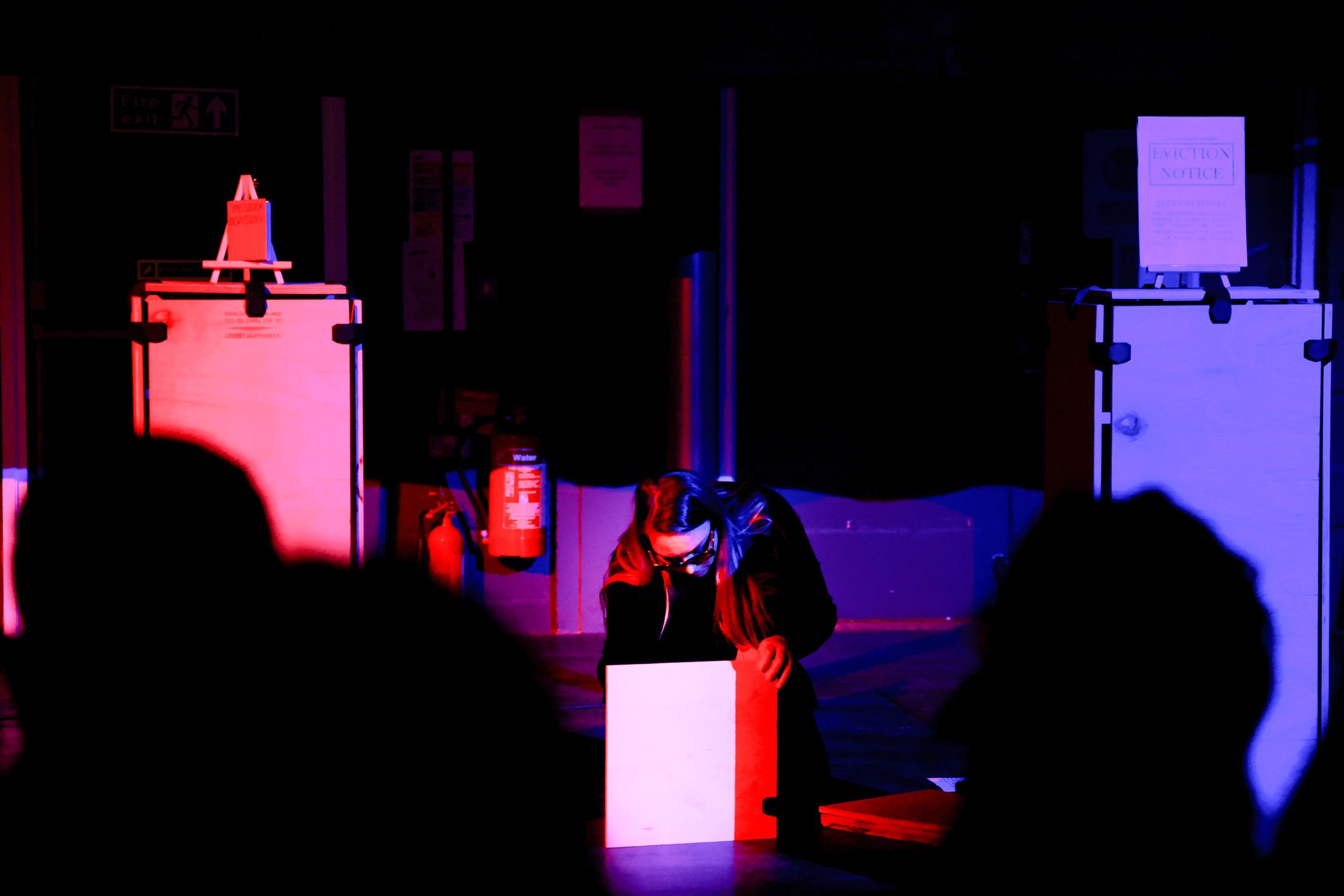That Boy Has No Shoes
What is it about?
That Boy Has No Shoes is an ‘immersive and emotional’ performance about Apartheid.
Four artefacts from the early Apartheid era, namely an axe, an eviction notice, a passbook, and a camera appear on plinths and address the audience through the microphone. Onstage, they become the repositories for the Apartheid struggle and tell stories of who they saw, what they did and where they were left behind. Lara facilitates the space, silently constructing a plinth in the background and ritualistically preparing the microphone for each artefact. Her own testimony comes at the end.
Intermixing folksong with narrative storytelling, this ‘poignant production’ pays tribute to the South Africans who fought for democracy, highlighting riots, forced removals and protests that shaped the cultural and economic landscapes of democratic South Africa. The result is ‘compelling’ and ‘powerful’.
That Boy Has No Shoes, Wimbledon College of Arts, 2022 (Photo by Sophie Giddens)
When did the performance premiere?
That Boy Has No Shoes premiered to the public at Camden People’s Theatre on 29th July 2024 as part of The Camden Fringe 2024 for a limited run until 3rd August. The show was praised by audiences and theatre critics alike, receiving resounding 4-star reviews from The Reviews Hub, Everything Theatre and A Young(ish) Perspective for its emotional script and immersive staging.
Read Lara ’s interview with Tom Kihl from The Camdenist here >
Where did the inspiration come from?
In 2018, Lara moved to London from South Africa to study acting. For one of her classes she had to prepare a presentation on any theatre of her choice and decided to research and talk about the Johannesburg Market Theatre. This theatre is nicknamed the ‘theatre of struggle’ for its groundbreaking work during Apartheid. During the presentation, Lara ’s tutor asked her to stop and briefly describe Apartheid for those who weren’t familiar with the term. Lara was surprised by the request and asked her peers to raise their hands if they knew what it was. Only three hands waved over 20 heads. In 2022, when Lara had the opportunity to choose a topic for her third-year research project at Wimbledon College of Arts, she made this performance to create increased visibility for Apartheid history in London.
Praise for That Boy Has No Shoes
‘The show is a tribute to those who have been victimized, struggled, and fought to dissolve the racially segregated policies […] The honesty and non-pretension that the audience feels in this story exemplify the hopes and courage of the young generations who are willing to excavate the “forgotten” or ignored stories and bring them to the center in the 21st century when many of us assume that South African Apartheid is a thing in the past, solved and closed.’
— Prof. Yuko Kurahashi, Kent State University
‘Picture yourself seated in a dark theater surrounded by the sounds of Africa; you hear the animals and the people and the traffic, then gunshots ring through the theater. That is your introduction to That Boy Has No Shoes. The selected experiences described to the audience are incredibly powerful. Each excerpt evokes outrage and empathy while deepening our understanding of the horrors of Apartheid.’
— A Young(ish) Perspective ★★★★
‘Her horror at understanding the violence of her country’s history is particularly interesting to reflect on for members of the audience who are older and grew up in the global reality of apartheid. The talent in this piece is that each viewer is forced to confront their own memory, or lack of understanding, of this period of history and question the validity of their perspective. As such it is both communal and individual, informative and challenging.’
— Everything Theatre ★★★★
‘The true strength of van Huyssteen’s delivery comes at the end, as the fifth plinth is completed and she stands to give her own testimony. Her story, as a white girl born after the end of apartheid but still witness to the divisions in society, is honest and heartfelt. It is a thought-provoking signal that the modern generation of South Africans, whatever their colour or background, is working to overcome the stains of history.’
— The Reviews Hub ★★★★





![That Boy Has No Shoes [3] Photo by Amanda Wu.jpeg](https://images.squarespace-cdn.com/content/v1/63928ff267e1b55209f710f0/86a7e899-5a36-46ca-81a7-c88a17ba4bdc/That+Boy+Has+No+Shoes+%5B3%5D+Photo+by+Amanda+Wu.jpeg)


